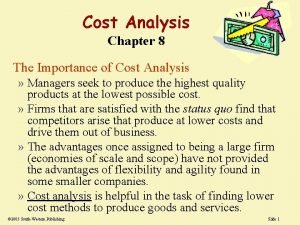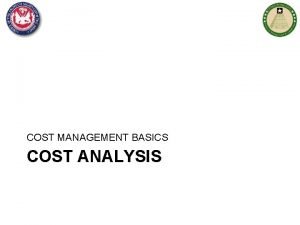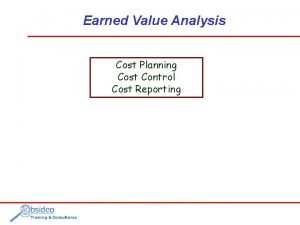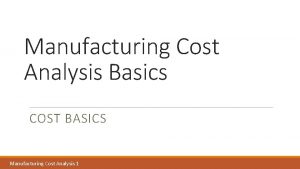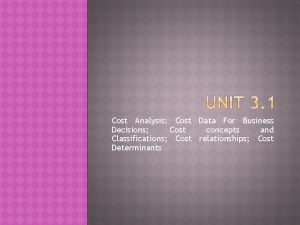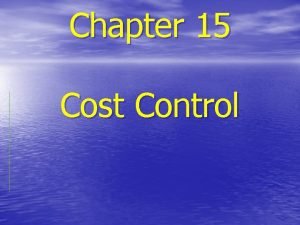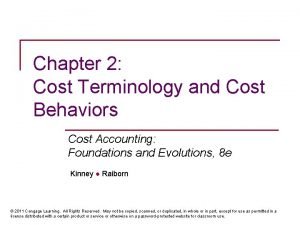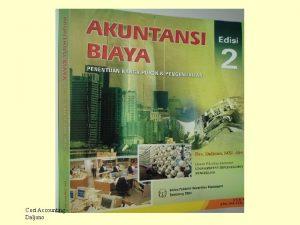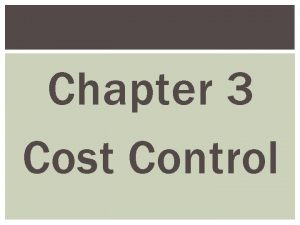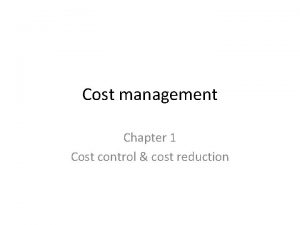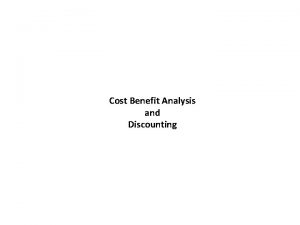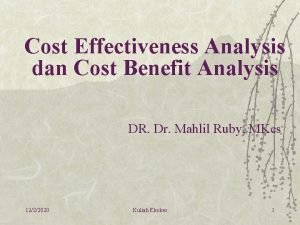Cost Analysis Chapter 7 The Importance of Cost















- Slides: 15

Cost Analysis Chapter 7 The Importance of Cost Analysis » Managers seek to produce the highest quality products at the lowest possible cost. » Firms that are satisfied with the status quo find that competitors arise that produce at lower costs and drive them out of business. » The advantages once assigned to being a large firm (economies of scale and scope) have not provided the advantages of flexibility and agility found in some smaller companies. » Cost analysis is helpful in the task of finding lower cost methods to produce goods and services. 2005 South-Western Publishing Slide 1

Managerial Challenge: US Airways • US Airways created in mergers with Allegheny, Mohawk, Lake Central, Pacific Southwest and Piedmont Airways. • Mostly in the East, with high cost but high yields (most seats were filled). • But, this situation invites entry by competitors by Continental or others. • The key to US Airways’ survival lays in managing its high cost. Slide 2

Meaning and Measurement of Cost There a number of cost concepts in business. • Opportunity Cost – value of next best alternative use. • Explicit vs. Implicit Cost – actual prices paid vs. opportunity cost of owner -supplied resources. Slide 3

Accounting vs Economic Cost • Accounting costs involve explicit historical costs. They attempt to use the same rules for different firms, so we can compare firm performance. • Economic costs are based on making decisions. These costs can be both implicit and explicit. » A chief example is that economic costs include the opportunity costs of owner-supplied resources such as time and money, which are implicit costs. » Economic Profit = Total Revenues - Explicit Costs Implicit Costs » Both explicit and implicit costs make economic profit lower than accounting profit Slide 4

• Depreciation Cost Measurement. Accounting depreciation (e. g. , straight-line depreciation) tends to have little relationship to the actual loss of value » To an economist, the actual loss of value is the true cost of using machinery. • Inventory Valuation. Accounting valuation depends on its acquisition cost » Economists view the cost of inventory as the cost of replacement. • Unutilized Facilities. Empty space may appear to have "no cost” » Economists view its alternative use (e. g. , rental value) as its opportunity cost. Slide 5

• Sunk Costs -- already paid for, or • • there already exists a contractual obligation to pay Incremental Cost - - extra cost of implementing a decision = TC of a decision Marginal Cost -- cost of last unit produced = TC/ Q SHORT RUN COST FUNCTIONS 1. TC = FC + VC fixed & variable costs 2. ATC = AFC + AVC = FC/Q + VC/Q Slide 6

Short Run Cost Graphs MC ATC 3. 1. AFC Q 2. AVC AFC Q MC intersects lowest point AVC of AVC and lowest point of ATC. When MC < AVC, AVC declines Q When MC > AVC, AVC rises Slide 7

Relationships Among Cost & Production Functions • AP & AVC are inversely related. (ex: one input) • AVC = WL /Q = W/ (Q/L) = W/ APL Q prod. functions AP » As APL rises, AVC falls • MP and MC are inversely related • MC = d. TC/d. Q = W d. L/d. Q = W / (d. Q/d. L) = W / MPL » As MPL declines, MC rises MPL cost AVC L MC cost functions Q (Figure 8. 3 on page 358) Slide 8

Problem Let there be a cubic VC function: VC =. 5 Q 3 - 10 Q 2 + 150 Q 1. find AVC from the VC function above. 2. find minimum variable cost output from AVC. 3. and find MC from the VC function A 1: AVC =. 5 Q 2 -10 Q + 150 (divide by Q) A 2: Minimum AVC is where d. AVC/d. Q = 0 d. AVC / d. Q = Q - 10 = 0 Q = 10, so AVC = 100 @ Q = 10 A 3: MC= d. VC/d. Q= 1. 5 Q 2 - 20 Q + 150 Slide 9

Long Run Cost Functions • All inputs are variable in the long run • LAC is long run average cost SMC 2 SAC 2 LMC » ENVELOPE of SAC curves • LMC is FLATTER than SMC curves • The optimal plant size for a given output Q 2 is plant size 2. (A SR concept. ) • However, the optimal plant size occurs at Q 3, which is the lowest cost point overall. (A LR concept. ) LAC Q 2 Q 3 Q Slide 10

Long Run Cost Function (LAC) Envelope of SAC curves Ave Cost SAC-small capital SAC-med. capital SAC-big capital LAC--Envelope of SRAC curves Figure 8. 4 on page 360 Q Slide 11

Economists think that the LAC is U-shaped • Downward section due to: » Product-level economies which include specialization and learning curve effects. » Plant-level economies, such as economies in overhead, required reserves, investment, or interactions among products (economies of scope). » Firm-level economies which are economies in distribution and transportation of a geographically dispersed firm, or economies in marketing, sales promotion, or R&D of multi-product firms. Slide 12

LAC • Flat section of the LAC CRS region DRS » Displaces constant returns to scale MES Max ES » The minimum efficient scale (MES) is the smallest scale at which minimum per unit costs are attained. • Upward rising section of LAC is due to: » diseconomies of scale. These include transportation costs, imperfections in the labor market, and problems of coordination and control by management. » The maximum efficient scale (Max ES) is the largest scale before which unit costs begin to rise. » Modern business management offers techniques to avoid diseconomies of scale through profit centers, transfer pricing, and tying incentives to performance. Slide 13

Problem Q Suppose we have the following info: TC = 200 + 5 Q -. 4 Q 2 +. 001 Q 3 MC = 5 -. 8 Q +. 003 Q 2 1. 2. 3. 4. FIND fixed cost FIND AVC function FIND AVC at Q = 10 If FC rises $500, what happens to the average variable cost function? Slide 14

TC = 200 + 5 Q -. 4 Q 2 +. 001 Q 3 MC = 5 -. 8 Q +. 003 Q 2 1. FIND fixed cost Answer: FC = 200, the intercept in the TC curve. 2. FIND AVC function Answer: VC = 5 Q -. 4 Q 2 +. 001 Q 3 So AVC = 5 -. 4 Q +. 001 Q 2 (Divide VC by Q) 3. FIND AVC at Q = 10. Answer: Substitute Q = 10 into the AV C function. AVC = 5 -. 4(10) +. 001(102) = 4 – 4 +. 1 = 1. 1. 4. If FC rises $500, what happens to the average variable cost function? Answer: No change, since AVC does not include fixed cost. Slide 15
 Importance of cost analysis
Importance of cost analysis Importance of cost analysis
Importance of cost analysis Cost structure refers to the relative proportion of
Cost structure refers to the relative proportion of Hát kết hợp bộ gõ cơ thể
Hát kết hợp bộ gõ cơ thể Bổ thể
Bổ thể Tỉ lệ cơ thể trẻ em
Tỉ lệ cơ thể trẻ em Gấu đi như thế nào
Gấu đi như thế nào Tư thế worm breton là gì
Tư thế worm breton là gì Chúa sống lại
Chúa sống lại Môn thể thao bắt đầu bằng chữ f
Môn thể thao bắt đầu bằng chữ f Thế nào là hệ số cao nhất
Thế nào là hệ số cao nhất Các châu lục và đại dương trên thế giới
Các châu lục và đại dương trên thế giới Công thức tiính động năng
Công thức tiính động năng Trời xanh đây là của chúng ta thể thơ
Trời xanh đây là của chúng ta thể thơ Cách giải mật thư tọa độ
Cách giải mật thư tọa độ
